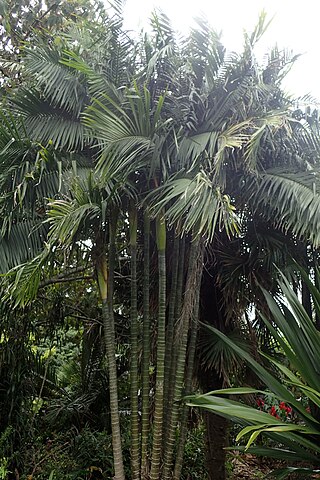
Dypsis decaryi is a species of flowering plant in the Arecaceae family. It is commonly known as the triangle palm. It is indigenous to the Madagascan rainforest. Some specimens grow to a height of some 15 metres (49 ft) in the wild. It is relatively new to cultivation however, so outside its native habitat it rarely achieves anything like that height. The leaves are about 2.5 metres in length, growing almost upright from the trunk and arching gracefully outward about a metre from their tips. The leaf bases are arranged in three vertical columns set about 120 degrees apart on the main stem, forming a triangular shape in cross section. This shape has given rise to the palm's common name.

Dypsis ambositrae is a species of flowering plant in the family Arecaceae. It is found only in Madagascar where it is threatened by habitat loss.
Dypsis antanambensis is a species of flowering plant in the Arecaceae family. It is a palm endemic to Madagascar, where it grows in rainforests. The whole population occurs within Mananara-Nord National Park and there are fewer than 50 mature individuals estimated to remain.
Dypsis basilonga is a species of flowering plant in the family Arecaceae. It is endemic to Madagascar. It grows in humid, mossy habitat on mountains. It is threatened by overharvesting.
Dypsis bejofo is a species of flowering plant in the Arecaceae family. It is a palm endemic to Madagascar. It grows on hilltops and slopes in rainforest habitat. The species is threatened by overcollection of seeds and by habitat loss. There may be only about 300 mature individuals remaining. Some grow in protected areas.
Dypsis canaliculata is a species of flowering plant in the family Arecaceae. It is found only in Madagascar, and has not been seen since 1951. It therefore may be extinct. At the times when specimens were collected, they were found far apart geographically, but both were growing on sandstone in lowland forest regions. To date no flowers from D. canaliculata have ever been collected for science.
Dypsis canescens, also known as Chrysalidocarpus canescens, is a species of flowering plant in the family Arecaceae. It is endemic to the Sambirano region of northwestern Madagascar. It was identified in 1913. It is probably extinct, given that it has not been seen for half a century.
Dypsis dransfieldii is a species of flowering plant in the Arecaceae family. It is a palm endemic to Madagascar that grows on white sands in lowland forest habitat. Populations are protected in Masoala National Park.
Dypsis faneva is a species of flowering plant in the Arecaceae family. It is a palm endemic to Madagascar, where it grows in rainforests. It is threatened by habitat destruction. Fewer than 70 mature individuals are thought to remain.
Dypsis heteromorpha is a species of flowering plant in the family Arecaceae. It is found only in Madagascar. It is threatened by habitat loss.
Dypsis ligulata is a species of flowering plant in the family Arecaceae. It is found only in Madagascar. It is threatened by habitat loss.

Dypsis madagascariensis is a species of flowering plant in the family Arecaceae. It is found only in Madagascar. It is threatened by habitat loss.
Dypsis onilahensis is a species of palm tree in the family Arecaceae. It is endemic to Madagascar as is reflected in the species name (onilahensis) referring to the Onilahy River, south of Toliara. It is threatened by habitat loss.
Dypsis perrieri is a species of flowering plant in the family Arecaceae. It is found only in Madagascar. It is threatened by habitat loss.
Dypsis rivularis is a species of flowering plant in the Arecaceae family. It is palm endemic to Madagascar, where it grows in forests near rivers. It is threatened by habitat loss. There are fewer than 100 mature individuals estimated to remain.
Dypsis singularis is a species of flowering plant in the Palm Family. It is found only on the island of Madagascar. It is threatened by habitat loss. It is remarkable for its height to width ratio; the greatest of any tree. It is up to 19ft 8in tall while being only 2/5ths of a inch in diameter, a length/width ratio of 600 fold.
Dypsis tsaravoasira is a species of flowering plant in the Arecaceae family. It is a palm endemic to Madagascar, where it grows in rainforests. There are perhaps 500 plants remaining, and the population is decreasing due to overharvest.
Masoala kona is a species of flowering plant in the Palm Family. It is a palm endemic to Madagascar, where it grows in rainforests. There are fewer than 60 individuals estimated to remain. Its most remarkable feature is that its leaves bear the longest "segments" of any plant; up to 8.2 feet in length. A leaf segment has a broad attachment to the rachis rather than a petiolule. It differs from a lobed leaf in that the lamina (leaf) is not continuous. The species is threatened by habitat loss.
Dypsis brevicaulis is a species of flowering plant in the Arecaceae family. It is a dwarf palm found on only three sites in Madagascar, with fewer than fifty plants ever found in the wild. The plant is part of the IUCN Sampled Red List Index for Plants, a study of representative species from all over the world which is studying extinction trends for plants.

Dypsis baronii is a species of palm tree in the family Arecaceae. It is otherwise known as "sugarcane palm" because of the scars on its trunks that resemble sugarcane.





